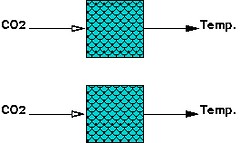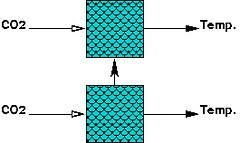Warning: Long post...
Okay, let's talk about models, uncertainty, feedbacks, prediction, etc., etc. Models are fundamental tools in modern science. They are very important to our understanding of the reality and impacts of climate change, as well as the potential solutions. So what is a model? A scientific model is a simplified view of some aspect of the natural world. A good scientific model is a well-crafted balance between simplicity and complexity. Too simple a model ignores knowledge that may be critical to our problem. Limits to model complexity, on the other hand, are usually set by limited knowledge of the problem, or how all the bits of knowledge fit together, or how to actually make those bits work together when we know that they should, or most commonly, the model becomes so specific that it fails to be useful for general inference.
An example of good models is the family of General Circulation Models (GCMs), those mathematical descriptions of how geophysical fluids (atmosphere and oceans) flow about the Earth. We've had atmospheric and oceanographic GCMs for decades, but the really cool ones are the coupled atmosphere-ocean GCMs. Today we use these models to predict what global temperatures (among other things) might be in the future under different conditions (e.g. different levels of carbon dioxide emissions). Generally, a GCM divides up the Earth's surface into a grid, and the atmosphere into cuboids, inputs known or speculative data for each grid or cuboid (a "cell"), and using the laws of physics (thermodynamics, hydrodynamics, etc.), sets the whole thing flowing. The model is run for N number of time stps, the properties of each cell being updated at each step. Eventually, the model is stopped and the result is a time (and space) series of global climate history or predictions.
Is this a big deal? Oh, very much so. At the very least, we have to keep track of what every cell looks like. A trivial GCM might look something like this:
We plug a CO2 concentration into each cell and a formula produces a temperature. You could do this on a spreadsheet (such as OO_Calc), with each row a cell on the Earth's surface, and each column a time step. The more cells you have, the more finely you've divided up the surface, and the higher the resolution of your model! If you really wanted to do this right, you'd need a big machine, like this one. Now imagine that the cells are not independent of each other, but that they can exchange properties such as CO2 or temperature. Certainly a region of high CO2 emissions is likely to spill some over to its neighbours (Ahem nations: you know who I'm talking about). Our model might now look like this:
A bit more "complex"; the model now comprises numerous interacting parts. (By the way, if you figure out how to run this one on your spreadsheet, let me know; you'll probably need a bigger machine).
Finally, consider that not only cells, but the processes in cells might interact. For example, increasing CO2 leads to warmer air temperatures over Siberia, where the permafrost in turn begins to thaw, which in turn causes decomposition of buried organic materials, which in turn causes the release of methane gas, which in turn adds to the greenhouse effect in the atmosphere and, on the short-term adds to temperature increase, and on the long-term is converted to CO2 thus further adding to the model input. Whew. Our model might now look like this:
Now that's feedback! In this case a positive feedback, because it amplifies the processes.
Okay, if your head now hurts, just dim your monitor and don't blame me (or any other modelers); the world is as the world is. More next time.
Powered by ScribeFire.